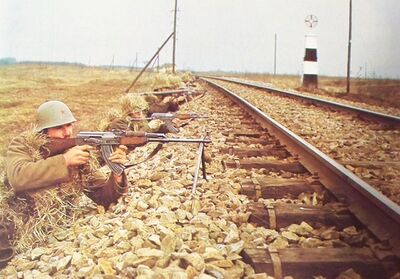Vinyan War
| Vinyan War | |||||||
|---|---|---|---|---|---|---|---|
 Kolodorian infantry during the Radstadt Campaign. | |||||||
| |||||||
| Belligerents | |||||||
|
|
| ||||||
| Commanders and leaders | |||||||
|
|
| ||||||
| Strength | |||||||
|
|
| ||||||
| Casualties and losses | |||||||
|
550,000 killed 1,500,000 wounded |
350,000 killed 950,000 wounded | ||||||
The Vinyan War (Kolodorian: Vinija Karš) was a war between Kolodoria (with the support of Polvokia) and the Anglo-Ivernic Coalition composed of Tír Glas, Anglia and Lechernt, and the other Ivernic states. The war began on 10 April 1975 when Kolodoria invaded Tír Tairngire following decades of border disputes and tension.
At the height of the Anglian Empire, the region known as Zavijava came under Anglian control but was inhabited primarily by ethnic Kolodorians. Tír Tairngire was granted independence in 1968 from the Anglian Empire, but retained control of Zavijava. The establishment of the Socialist Republic of Kolodoria in 1954 and the subsequent growth of Kolodoria as a major power in Vinya led to increased tensions between the two states, in large part due to the nationalist and expansionist desires of Kolodorian dictator Aleksis Kraulis. Beginning in 1972 Kraulis began lobbying the Tairngiric government for a peaceful transfer of control of Zavijava to Kolodoria. While the Tairngiric government did not completely disavow the idea, suspicions around Kolodoria's communist government and the trustworthiness of Kraulis undermined negotiations, and after dragging on for two years Kolodoria withdrew from the negotiations and began planning an invasion.
Kolodoria invaded Tír Tairngire in 1975 and made rapid progress as the much larger Kolodorian People's Defense Forces routed the Tairngiric Armed Forces in a series of clashes in Zavijava. The invasion prompted condemnation by Tír Glas, Anglia and Lechernt, and the other Galenic states, whom declared war on Kolodoria and deployed. By May Kolodorian forces had seized nearly all of Zavijava, however their rapid success led Kraulis to believe that even more territory could be gained and he ordered the KPDF to push even farther south. Through the summer Kolodorian forces seized Ballindine and Lahardane, but were halted by a combined Anglo-Ivernic forces outside Knightstown and Newtown. The Anglo-Ivernic Coalition would then push Kolodorian forces back across the entire front, and by December 1975 had restored the pre-war borders.
Believing it necessary to destroy further Kolodorian ability to wage war, the Coalition then invaded the southern Jedorian regions which held much of Kolodoria's industry and agriculture. By July 1976 the Coalition had captured Dranga, Elgin, Strana Mecthy and Leoben and were threatening to cross the Luminovian Canal the heart of Kolodoria. In response, Kolodoria opened a second front in Tír an Crainn, invading the Galenic nation on 19 July. Caught off guard, the Coalition was forced to divert much needed manpower and supplies to the newly formed Crainnic Front, allowing the Kolodorians to reinforce their lines in the east. In August they launched a major counter-offensive in Jedoria, and proceeded to drive Coalition forces south in a series of hard fought campaigns. By January 1977 the Kolodorians had recaptured Zavijava but were halted in the central highlands of Tír Tairngire. The situation on the Crainnic Front continued to swing back and forth until the summer of 1977, at which point the entire war settled into a stalemate, with both sides launching large scale but ultimately unsuccessful offensives.
Ceasefire negotiations began in late 1978 but dragged on for over a year as both sides attempted to leverage their position by military success on the battlefield, which resulted in tens of thousands of casualties on each side. By early 1980 Coalition forces had driven the Kolodorians back to the northern mountains of Tír an Crainn, but attempts to dislodge Kolodoria from Zavijava failed. A peace agreement was finally signed in 1980 following mediation by Themiclesia, and the war officially ended on 4 October. Per the terms of the armistice, Kolodoria gained control of Zavijava, fulfilling the original goal of the invasion but was forced to withdraw all other military forces from territory occupied during the war.
The bloodiest war fought in Vinya since the Northern War, the Vinyan War had a severe political and psychological impact on Vinya and the states involved. Kolodoria's war effort incurred billions in debt, but convinced Kraulis of Kolodoria's ability to take what it wanted through military force, leading to later conflicts against Vyzhva and the Cherniyan War. The Vinyan War would profoundly impact the development of the Vinyan Defense Union and the development of the Ivernic nations post-independence.